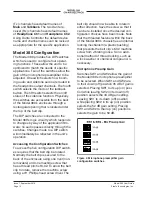
Issue 1, September 2016
Model 380 User Guide
Page 10
Studio Technologies, Inc.
Headphone Output
The Model 380 provides a 2-channel head-
phone output by way of a 3-conductor
¼-inch phone jack. Devices such as stereo
headphones or stereo (“dual-muff”) broad-
cast-style headsets can be directly con-
nected using a 3-conductor ¼-inch plug.
Following the usual convention the left
channel should be terminated on the tip
lead, the right channel on the ring lead,
and common on the sleeve lead.
It’s also possible to use a monaural (“single-
muff”) headset or broadcast-type single
earbud but some care must be taken. If
a 3-conductor ¼-inch plug is used by the
device it should be wired to the tip and
sleeve leads; the plug’s ring lead should
be left unconnected. But it’s also very likely
that the monaural device will be terminated
on a 2-conductor (“tip and sleeve”) plug.
When the plug is inserted into the Model
380’s headphone jack the Model 380’s right
headphone output channel will be shorted;
the ring lead will be directly shorted to the
sleeve lead. This can lead to stress on the
right channel headphone output circuitry
as well as extra current draw. To prevent
this condition the headphone output mode
configuration choice (DIP switch 3) should
be set for monaural. This disables the right
headphone output channel and sends the
listen audio sources only to the left output
channel. Refer to the Configuration section
later in this guide for details on setting the
headphone audio routing.
Microphone Output
A 3-pin male XLR connector provides a
microphone-level output that’s directly
related to the microphone input. Techni-
cally the output is identical to the signal
that’s connected to the microphone input
but with a solid-state muting circuit in series
with the interconnection. When the Model
380’s Dante main output channel is active
the microphone signal passes through
to the Model 380’s microphone output.
When the main output channel is muted
(and the Dante talkback channel is ac-
tive) the microphone signal does not pass
through to the microphone output; it’s is
muted in an essentially click-free manner.
Refer to Appendix A, located at the end
of the guide, for a block diagram of the
microphone input and microphone output
circuitry. Studying this diagram can help
illuminate one of the more unique Model
380 features.
The microphone output can be connected
to a balanced (differential) analog micro-
phone-level input on a variety of devices.
When the Model 380 was designed the
primary target devices were portable
ENG-style video cameras that included
microphone inputs. The mic inputs on
these cameras are typically amplified and
then embedded with the video signal into
an SDI output. This would ensure that
“lip sync” would be maintained since the
audio and video would travel on the same
digital stream. The Model 380’s Dante
main output channel would not be used or
would only be used as a backup path. The
microphone output can also be connected
to mic inputs on audio consoles or to con-
sole remote I/O interfaces, e.g., Calrec®
Hydra2®.
No preamplifier or other active circuitry
impacts the path from the Model 380’s
microphone input connector to the Model
380’s microphone output connector. The
signal does pass through a 200 ohm resis-
tor in each “leg” (pin 2 and pin 3) along
with connecting to a solid-state relay
contact. The result is that the source
Содержание M380
Страница 2: ...This page intentionally left blank...







































